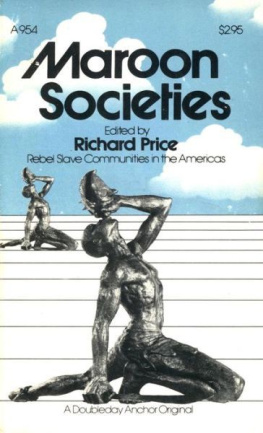MAROONS AND THE MAROONED
ANTON L. ALLAHAR AND NATASHA BARNES
Series Editors
MAROONS
AND THE
MAROONED
Runaways and Castaways
in the Americas
Edited by
Richard Bodek and Joseph Kelly
University Press of Mississippi / Jackson
The University Press of Mississippi is the scholarly publishing agency of the Mississippi Institutions of Higher Learning: Alcorn State University, Delta State University, Jackson State University, Mississippi State University, Mississippi University for Women, Mississippi Valley State University, University of Mississippi, and University of Southern Mississippi.
www.upress.state.ms.us
The University Press of Mississippi is a member of the Association of University Presses.
Copyright 2020 by University Press of Mississippi
All rights reserved
Manufactured in the United States of America
First printing 2020
Library of Congress Cataloging-in-Publication Data
Names: Bodek, Richard, 1961- editor. | Kelly, Joseph, 1962- editor.
Title: Maroons and the marooned: runaways and castaways in the Americas / edited by Richard Bodek and Joseph Kelly.
Description: Jackson: University Press of Mississippi, 2020. | Series: Caribbean studies series | Includes bibliographical references and index.
Identifiers: LCCN 2019058813 (print) | LCCN 2019058814 (ebook) | ISBN 9781496827203 (hardback) | ISBN 9781496827197 (trade paperback) | ISBN 9781496827210 (epub) | ISBN 9781496827227 (epub) | ISBN 9781496827234 (pdf) | ISBN 9781496827241 (pdf)
Subjects: LCSH: Maroons. | Maroons in literature. | AmericaHistory. | BISAC: HISTORY / Americas (North, Central, South, West Indies)
Classification: LCC E450 .M385 2020 (print) | LCC E450 (ebook) | DDC 305.5/122097dc23
LC record available at https://lccn.loc.gov/2019058813
LC ebook record available at https://lccn.loc.gov/2019058814
British Library Cataloging-in-Publication Data available
We would like to dedicate this book to all the students whom we taught in our College of Charleston Honors Course, Marooned! These students were always an inspiration, always pushed us to look at the phenomenon in a new light, and motivated us to mount the conference that inspired the book in your hands.
SPRING 2008 | SPRING 2012 | SPRING 2016 |
Laurel Black | John Brooker | Alexandra Astor |
Robyn Burrows | Cara Bujanowski | Peter Bruno |
Anna Chard | Mary Crowe | Erik Cardwell |
Jody Christian | Zachary Huey | Laura Cox |
Jarryd de Boer | Mollianna Judd | Shana Devlin |
Tan-ni Fan | Kristen McLinko | Joseph Dibrigida |
Ashlee Fields | Andrew Nelson | Sarah Ford |
Natasha Hoover | Franklin Peters | Wilson Ford |
Valerie Kneece | Mary Rumble | Abigael Malcolm |
Sophia Lee | Brandi Schumacher | Travis McGowin |
Sharon McMullen | Jacqueline Tully | Sophie Naughton |
Alex Modley | Margaret Turner | Julie Reams |
Lucas Nelson | Alice Van Arsdale | Baylee Sims |
Cindy Oliva | Samantha Wilds | Catherine Stiers |
Kellie Osborne | Emily Wise |
Erica Sheftic |
Courtney Skibbe |
Kirsten Shumy |
Shanaya Suchak |
Mary Foster Williams |
Contents
J. Brent Morris
James ONeil Spady
Edward Shore
Steven Mentz
Peter Sands
Simon Lewis
Claire Curtis
Richard Bodek
Joseph Kelly
Acknowledgments
We would like to acknowledge everybody who made this book possible. The College of Charlestons Program in the Carolina Lowcountry and Atlantic World, under its phenomenal director, Simon Lewis, provided the intellectual and institutional space for the conference that inspired this collection. The Colleges Anthropology, English, and History Departments provided both financial and intellectual support. Vijay Shah, our original editor at the University Press of Mississippi, always showed great enthusiasm for, and interest in, the work and its potential place in the field of cultural studies. Finally, perhaps our chief intellectual debt belongs to Sally and Richard Price, whose high standards forced both the original conference and this book to be as theoretically acute and precise as possible. They never allowed either us or any of our contributors to take the easy way out. For this we will always be grateful.
Introduction
Marooned is what happens to castaways. At least in common use, it is a transitive verb: the hand of God (usually through the agency of a sea storm) or ones ship captain (as a punishment) maroons the unfortunate voyager in a deserted wilderness. Zeus marooned Odysseus on Ogygia with a thunderbolt. A hurricane marooned the Sea Venture on the uninhabited Bermuda archipelago. The writer Daniel Defoe marooned Robinson Crusoe on a Caribbean island and in so doing helped define a cultural genre, with its concomitant themes, motifs, and conventions. In modern culture, the scene of action sometimes shifts to outer space or landscapes of the zombie apocalypse, strange new worlds in which survivors struggle to remake civilization. But the fundamentals remain. The robinsonade endures as one of our more ubiquitous narrative templates. It is the argument of this book that American culture uses such tales to redefine national identity and reaffirm democracy.
Most historians and anthropologists know that maroon has an older usage. Originally, it referred to cattle that escaped colonial farms on Hispaniola and fled into the backcountry, where they shucked off their domestication and regained their wildness. The Spanish called them cimmarn. Most scholars today accept that this usage was current in the Spanish language by 1535. Just five years later, the term was used (first metaphorically and later literally) to describe human chattel who did the same thing: bound to Spanish plantations or mines, Africans slipped their shackles and escaped into the wilderness, where, according to the Spanish point of view, they reverted to their own wildness. The English became familiar with the term through Francis Drakes pirate raids on Panama in the 1570s, when he teamed up with escaped slaves, or Symerons, living in the hinterland. The word maroon first appeared in English print in 1666, when John Davies, translating a history of Barbados, wrote that some of the enslaved people, like Panamas










